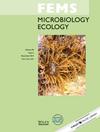在 750 米深的地下热液微生物群落中量化基因组特异性碳固定。
IF 3.5
3区 生物学
Q2 MICROBIOLOGY
引用次数: 0
摘要
据推测,溶解的无机碳可刺激微生物的化能自养活动,成为深层地下环境碳循环中的一个生物汇。在这里,我们使用定量 DNA 稳定同位素探针对来自比加半岛(土耳其)750 米深地下含水层的热液中多种 13C 标记碳酸氢盐浓度下的元基因组组装基因组(MAGs)进行了测试。同化 13C 标记碳酸氢盐的微生物种群的多样性在碳酸氢盐浓度较高时显著不同,这可能与 13C 标记 MAGs 中编码的四种不同的碳固定途径有关。在测试的所有碳酸氢盐浓度(1-10 毫摩尔)范围内,编码卡尔文-本森-巴萨姆循环的微生物种群对碳固定的贡献最大。然而,在检测到的所有活性碳固定途径中,隶属于水螅门的编码反向三羧酸(rTCA)途径的 MAGs 是唯一在碳酸氢盐浓度增加的情况下表现出 13C 碳酸氢盐同化增加的微生物种群。我们的研究首次提供了实验数据,支持碳酸氢盐浓度增加可通过 rTCA 循环及其深层地下无机碳生物汇促进化能自养的预测。本文章由计算机程序翻译,如有差异,请以英文原文为准。
Quantifying genome specific carbon fixation in a 750 meter deep subsurface hydrothermal microbial community.
Dissolved inorganic carbon has been hypothesized to stimulate microbial chemoautotrophic activity as a biological sink in the carbon cycle of deep subsurface environments. Here, we tested this hypothesis using quantitative DNA stable isotope probing of metagenome assembled genomes (MAGs) at multiple 13C-labeled bicarbonate concentrations in hydrothermal fluids from a 750 meter deep subsurface aquifer in the Biga Peninsula (Turkey). The diversity of microbial populations assimilating 13C-labeled bicarbonate was significantly different at higher bicarbonate concentrations, and could be linked to four separate carbon fixation pathways encoded within 13C-labeled MAGs. Microbial populations encoding the Calvin-Benson-Bassham cycle had the highest contribution to carbon fixation across all bicarbonate concentrations tested, spanning 1-10 mM. However, out of all the active carbon fixation pathways detected, MAGs affiliated with the phylum Aquificae encoding the reverse tricarboxylic acid (rTCA) pathway were the only microbial populations that exhibited an increased 13C-bicarbonate assimilation under increasing bicarbonate concentrations. Our study provides the first experimental data supporting predictions that increased bicarbonate concentrations may promote chemoautotrophy via the rTCA cycle and its biological sink for deep subsurface inorganic carbon.
求助全文
通过发布文献求助,成功后即可免费获取论文全文。
去求助
来源期刊

FEMS microbiology ecology
生物-微生物学
CiteScore
7.50
自引率
2.40%
发文量
132
审稿时长
3 months
期刊介绍:
FEMS Microbiology Ecology aims to ensure efficient publication of high-quality papers that are original and provide a significant contribution to the understanding of microbial ecology. The journal contains Research Articles and MiniReviews on fundamental aspects of the ecology of microorganisms in natural soil, aquatic and atmospheric habitats, including extreme environments, and in artificial or managed environments. Research papers on pure cultures and in the areas of plant pathology and medical, food or veterinary microbiology will be published where they provide valuable generic information on microbial ecology. Papers can deal with culturable and non-culturable forms of any type of microorganism: bacteria, archaea, filamentous fungi, yeasts, protozoa, cyanobacteria, algae or viruses. In addition, the journal will publish Perspectives, Current Opinion and Controversy Articles, Commentaries and Letters to the Editor on topical issues in microbial ecology.
- Application of ecological theory to microbial ecology
- Interactions and signalling between microorganisms and with plants and animals
- Interactions between microorganisms and their physicochemical enviornment
- Microbial aspects of biogeochemical cycles and processes
- Microbial community ecology
- Phylogenetic and functional diversity of microbial communities
- Evolutionary biology of microorganisms
 求助内容:
求助内容: 应助结果提醒方式:
应助结果提醒方式:


